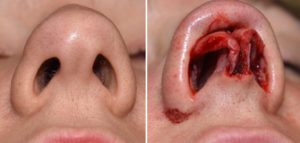The shape of the nose amongst people is as different as that of fingerprints. Between the innumerable size and thicknesses of the bone and cartilage that make up the nose and its thick or thin skin cover, the variability in nose shapes is endless. What rhinoplasty can do is to change the shape and thicknesses of the supporting bone and cartilage framework onto which the skin covers it. The skin of the nose is rarely, if ever, surgically altered by removal.

Repair of the bifid nasal tip is done by closing the gap between the separated cartilages through suture techniques in an open rhinoplasty approach. In some cases a cartilage graft (columellar strut) may also be used to fill in the gap. As the skin follows what the cartilage looks like underneath the groove on the skin disappears after surgery.
Dr. Barry Eppley
Indianapolis, Indiana


